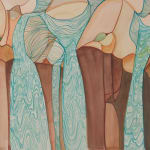

Chen Duxi Chinese, b. 1983
50 x 70 cm
For Chen Duxi, Remote Antiquity transcends the idea of “antiquity.” It embodies a primal clarity, a journey from raw, chaotic impressions to vivid, articulate expression. Chen draws inspiration from the stone carvings of the Wei and Jin dynasties (220–420 CE), which he sees as capturing the birth of a new form of artistic expression. These early works, unbound by rigid systems, radiate a raw, unrefined vitality. In much the same way, Remote Antiquity reimagines the waterfall—an enduring motif in Chinese art—through the lens of the artist’s personal visual experience.
《高古》
正如《持颐》系列中的其他作品,《高古》强调的也是一种全身心投入式的观察。这件作品描绘的是雅鲁藏布峡谷中的小瀑布,岩石在长期冲刷后被流水凿出光滑的表面,甚至改变了石头本身的坚硬的形象。这种质感被陈督兮幽默地类比为“被勺子挖过的冰淇淋”。长时间观察水流过光滑的岩石表面,则带来了水即便在往下坠却在逆流而上的错觉,这种视觉现象也被称为运动后效。画面中波浪形的水纹使得水仿佛在下流又好似在上升,切割后平面化的岩石更模糊了空间关系。对于陈督兮而言,“高古”不仅在于“古”。所谓高古其实也表示由混沌体验到清晰表达带来的原生感。好比魏晋时期的石刻画像,它们代表了一种新的表现形式的诞生。但是作为中国早期艺术,这些表现形式的运用尚未成体系,也因此充满生命力。这种形式上的超越性也可谓一种创新。而《高古》也意在以一种忠于艺术家视觉经验的方式重新诠释瀑布这一贯穿中国艺术的题材。


